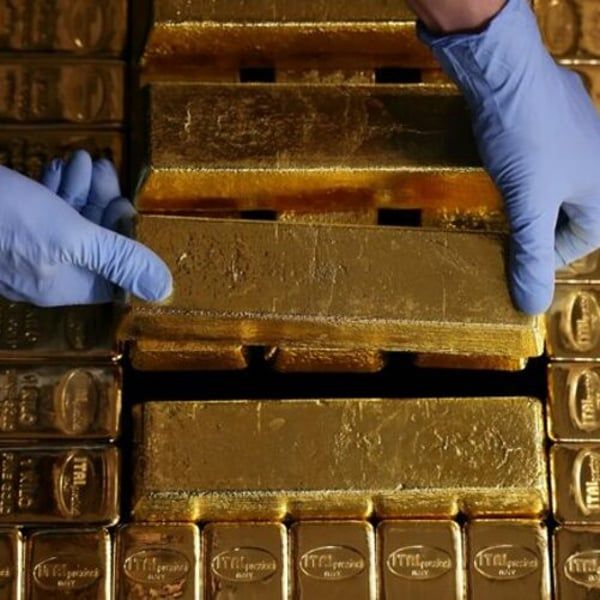By
Bloomberg
Published
September 11, 2025
Gold has eclipsed its peak adjusted to the established inflation more than 45 years ago, since the growing anxiety for the economic trajectory of the United States has been the three -year bull of deeper bilhes in unknown territory.
The spot price of gold has increased around 5% so far this month, with prices reaching a historical maximum of $ 3,674.27 per ounce on Tuesday. He has already established more than 30 nominal records in 2025, but the last stretch of the rally has also taken it through a peak adjusted by inflation on January 21, 1980, when prices increased by $ 850.
The factorization in decades of increases in consumer prices, that is equivalent to approximately $ 3,590, although there are multiple methods to adjust inflation, and some would put the 1980 peak at lower levels. It is a mobile objective, but analysts and investors agree that Gold has now firing firmly through it, providing an additional filling for gold credentials as an old coverage against the increase in prices and the weakening of the currencies.
“Gold is a very unique asset in its historical ability for hundreds, if not thousands of years to play that role,” said Robert Mullin, Marathon Resource Advisors portfolio manager. “Assets assignments are entering a period in which they are justifiably concerned about deficit spending levels, as well as questioning the priorities and will of central banks to really fight inflation.”
The precious metal has increased almost 40% this year, since President Donald Trump has reduced taxes, expanded his global commercial war and sought an unprecedented influence on the Federal Reserve. A massive sale in the US government bonds.
When gold reached $ 850 in January 1980, the United States was dealing with a collapse currency, an increase in inflation and a developing recession. The price had doubled in the previous two months, after the president of the United States, Jimmy Carter, issued a freezing about Iranian assets in response to a hostage crisis in Tehran, increasing the perceived risk of having active dollars for some foreign central banks.
“Gold only reflects the renewed awareness that inflation can be and remains a problem, but also the uncertainty about the world,” said Carmen Reinhart, former senior vice president and chief economist of the World Bank group. The “role as an Gold inflation coverage was a seal of its popularity in the 70s and 80s, but you must look before the 1980s: Gold has always played an important role when there is uncertainty.”
Compared to the parabolic increase to the peak in 1980, and a precipitate collapse that followed, today's rally has developed much less volatility. That is partly due to the fact that the current market is much more liquid and accessible to investors, and also because it is attracting a broader base of investors that are compensating for weakness in traditional demand areas.
Thanks to the increase in prices, the courage value in the London vaults exceeded $ 1 billion for the first time last month, and also exceeded the euro as the second largest asset in the reserves of the Global Central Bank.
Grant Sporre, overall chief of metals and mining in Bloomberg Intelligence, has reviewed its analytical models to take a more complete account of the broad and diverse drivers behind the Gold stellar rally. They suggest that gold has a higher price in relation to historical norms, except in a crucial aspect: compared to US actions, gold still seems cheap, and says prices could jump higher if capital markets begin to grow.
“Gold is color and fashionable, but the market is happy to pay the price to ensure that insurance,” said Sporre.
It is a surprising return for an asset that was ridiculed by the central bankers during the 1990s and 2000s, such as the end of the Cold War, the birth of the Eurozone and the adhesion of China to the World Trade Organization marked in a new era of globalization backed by the dollar. As the stock markets took off, many private investors also turned their backs on gold.
This time, many central banks buy gold again to diversify their dollar currency holdings and isolate themselves with sanctions aimed at the adversaries of the United States. Prices have almost doubled since the invasion of Ukraine of Russia and a resulting freezing in the Kremlin abroad assets, and the concentrate was extended as institutional investors began to load following the inauguration of Trump.
The sporadic purchase of the Juergas in China and a resurgence in the popularity of the funds quoted in exchange, which have made gold more accessible to retail investors, have also provided support along the way.
“The movement of a unipolar world to a multipolar world, I think it has accelerated the vision of gold as an asset that central banks want to possess,” said Greg Sharenow, a Pacific Management Management Manager Management Co. “The people of high net worth have been seeing it in a similar way, and gold has been a great beneficiary of the expansion and diversification of asets.”
In the last two weeks, prices have exploded again, firing at the highest nominals of all time established in April after a range of scope. The last rupture has come to investors in the financial markets will bet that the Fed will soon begin to reduce interest rates to avoid a deceleration in hiring and a possible economic recession.
Historically, rates cuts have increased Gold's appeal in relation to yield assets such as treasure bonds, while exerting pressure on the dollar. And with Trump organizing an assault unprecedented to the independence of the Fed, the gold bulls are also increasingly alert about the possibility that the Central Bank can be forced to reduce aggressively rates even in the increase in inflation risks.
When a similar dynamic was strengthened in the early 1970s, with the dollar falling when the then President Richard Nixon pressed the Fed to keep the rates down the risks of inflation, he helped start a colossal rally in gold, with the twin oil shocks of that decade that helped to raise him to his peak of $ 850.
“I could read what was happening in the world: each country was building a huge debt, each country was printing money and degraded its currency,” said Jim Rogers, co -founder of the quantum fund next to George Soros, who began buying bullion in the early 1970s. “And I also read enough to know that gold and silver were a way of protecting themselves at times like that.”












